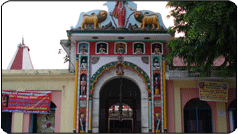Mahabir Temple
Despite allegiance to their own faith and religious practices, the Nawabs of Awadh had a secular approach towards the beliefs of the majority of their subjects and several historical accounts support this viewpoint.
Mirza Abu Talib Isphahani, a contemporary historian of Asaf-ud-DaulatVs reign, records that the Nawab spent five to six lakh annually on celebration of the festival of Holi.
The Hindu shrine of Suraj kund was the venue of a mela and Nawab Asaf-ud-Daulah rebuilt this dilapidated talaab (tank) for the convenience of devotees.
It was a coincidence that when Saadat Ali Khan arrived from Banaras to Lucknow on January 21, 1788, it was a Tuesday and a day marked for the celebration of Basant (spring) according to Najmui Ghani Khan [in Taareekh-e-Awadh]. On the same day he assumed the rule of Awadh at Daulat Khana palace while the deposed ruler, Wazir Ali, his nephew, was held under arrest at Kothi Bibiapur by the British Governor General's orders. Basant therefore marked an important day in the calendar of Saadat Ali Khan.
His son Ghazi-ud-Din Haider went a step ahead by initiating an annual Basant mela in 1814 at his Baradari in Hasan Bagh. It was mandatory for visitors to the fair to wear their best saffron coloured garments. Even birds and animals were coloured with yellow and the whole city turned Zaafraani (saffron coloured).
A Saawan mela to celebrate the advent of the rainy season, also known as jogia mela was held at Qaiser Bagh by the last King of Awadh, Wajid Ali Shah. It was started in 1853 and was held for three days in continuation when the general public was permitted to visit the royal gardens.
Wajid Ali as a Crown Prince and heir apparent staged the Rahas at Pari Khana, based on the Raas Leela of Lord Krishna. He is also said to have staged Inder Sabha, that related to fairies or apsara of the Court of Raja Indra. [This has been proved to be incorrect by iater analysts].
The writer himself has not come across any contemporary reference for this information, but Yogesh Praveen has written that foundation of the Ali gunj temple was laid by Bahu Begum Saheba, the mother of Asaf-ud-Daulah. The temple has a crescent moon on its spire and Rekha Misra in Women in Moghul India (cited by Surendra Mohan in Awadh under the Nawabs) commends it as a unique example of that (Bahu Begum's) period.
However, Surendra Mohan supports the view that the temple construction is connected with Janab-e-Aliya, the mother of Saadat Ali Khan, who nicknamed him Mangali, because the day he was born was a manga! (Tuesday) specific for the worship of Lord Hanuman [Mahabir]. According to him she was originally a Hindu princess.
However, an established fact relates the Mahabir temple to the freedom struggle of 1857, that the freedom fighters (rebel native sepoys) from Chinhat, on June 30, also a Tuesday, visited the Mahabir temple at Ali gunj seeking the blessings of Lord Rama's faithful follower Hanuman, popularly known as the bravest - Mahabir, before dividing into three groups for a three pronged attack on the English forces. The fight took place at Kukrail naala, Mariaon Cantonment and near the Iron Bridge (present day Dali gunj road bridge) on the river Gomti.
It was the success of this endeavour that encouraged the deposed King Wajid Ali Shah's troops Akhtari and Naadri that had been taken over by the British to join the freedom fighters and strengthen their struggle for over-throwing the illegally imposed British rule in Awadh.
However, there is another Hanuman temple in Ali gunj said to be built by a perfumery trader Lala Jat Mai in 1783, for installing a Hanuman idol unearthed by him following a 'divine guidance'. Since both the temples existed in 1857, it is not clear which of them is the one related with the visit of freedom fighters.
An annual fair is held on the first Tuesday of the month of Jeysht or Jeth (in summers) and is known as Bara Mangal ka mela. It draws heavy crowds at the two Ali gunj temples.
Today, with re-modelling, additions and alterations to the original structure, nothing of value remains there in archaeological terms except for the main shrine— the idol of Lord Hanuman in either of the two Mahabir temples.
However, the implicit faith in Ram Bhakt Hanuman has led other temples of the city to follow suit and hold Mangal mela in their premises on a particular Tuesday of the month of Jeth, when devotees come in large numbers with prasad offerings.
Source:
Hindustan Times, City Scan, A Time in History
Wednesday 13.1.1999 — Mahabir temples at Aligunj

